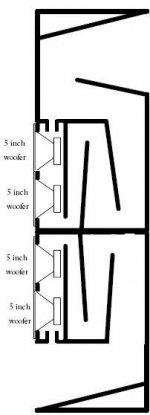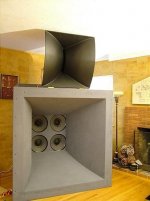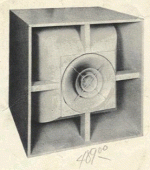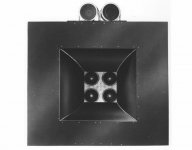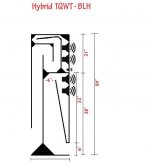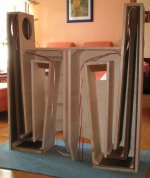Hello everybody  !!!
!!!
I search to build new SOUNDSTAGE and powerfull Loudspeaker.
Do you know if this design is possible ?
Is it possible to stuff the throat to reduce speed of sound to make very low frequency horn ?
Thanks in advance !
!
nicK
This loudspeaker is LINE ARRAY + DUAL BACK LOADED HORN front & rear END + BASS REFLEX HYBRID ENCLOSURE
I search to build new SOUNDSTAGE and powerfull Loudspeaker.
Do you know if this design is possible ?
Is it possible to stuff the throat to reduce speed of sound to make very low frequency horn ?
Thanks in advance
nicK
This loudspeaker is LINE ARRAY + DUAL BACK LOADED HORN front & rear END + BASS REFLEX HYBRID ENCLOSURE

Attachments
Hi Nick,
Certainly an interesting design but I am wondering about two things.
1. The difference in the length of the horns. This will mean they will unload at different frequencies. This may, I said may clutter the sound. This can be cured by firing both openings forward.
2. It's a bit of a mystery what the porting into the horn will do. It may further complicate matters. How would you tune them? Also, I think you will lose the advantage of the back loaded horn of you vent the compression chamber.
I know I didn't answer your questions but it may be that you are trying too hard to get the most from them. Others will have to chime in here as I don't qualify as an expert.
No, stuffing can only damp, it will not change the speed of sound. The frequency of the horn has to do with it's length and mouth size. It takes a very large horn to do low frequencies.
Certainly an interesting design but I am wondering about two things.
1. The difference in the length of the horns. This will mean they will unload at different frequencies. This may, I said may clutter the sound. This can be cured by firing both openings forward.
2. It's a bit of a mystery what the porting into the horn will do. It may further complicate matters. How would you tune them? Also, I think you will lose the advantage of the back loaded horn of you vent the compression chamber.
I know I didn't answer your questions but it may be that you are trying too hard to get the most from them. Others will have to chime in here as I don't qualify as an expert.
nickthevoice said:Is it possible to stuff the throat to reduce speed of sound to make very low frequency horn ?
No, stuffing can only damp, it will not change the speed of sound. The frequency of the horn has to do with it's length and mouth size. It takes a very large horn to do low frequencies.
You mentioned a good point . I loose the power for compression in the throat with this PORT (tuned at 50hz).
I take this at (Fostex FE126E enclosure)
Okay I accept to forgot the port !
In reality what's the difference in BLH
FRONT END vs REAR END ?
In my design it's the same four speaker Silverflute 5 inch tuned at the same frequency in BLH
MY GOAL IS CREATED POWERFULL SOUNDSTAGE LOUDSPEAKER
thanks
nicK
I take this at (Fostex FE126E enclosure)
Okay I accept to forgot the port !
In reality what's the difference in BLH
FRONT END vs REAR END ?
In my design it's the same four speaker Silverflute 5 inch tuned at the same frequency in BLH
MY GOAL IS CREATED POWERFULL SOUNDSTAGE LOUDSPEAKER
thanks
nicK
Iain McNeill said:I think you got the scale wrong when you photoshopped that speaker into your living room
I wish that was my living room. Anyway, those are 15" woofers. Here's the cinema configuration:
GM
Attachments
I don't understand why it's a problem to tune the speaker in two different frequency ?
This is my new design !!! HYBRID TQWT/BLH (5 inch silver flute)
TQWT tuned at 50hz other tuned at 30hz (if it's possbile)
I am looking to create loudspeaker can have a "strong soundstage" because I LOVE when the room behind loudspeaker is completely full of sound !
thankS
nicK
This is my new design !!! HYBRID TQWT/BLH (5 inch silver flute)
TQWT tuned at 50hz other tuned at 30hz (if it's possbile)
I am looking to create loudspeaker can have a "strong soundstage" because I LOVE when the room behind loudspeaker is completely full of sound !
thankS
nicK
Attachments
I dunno about GM... using horns designed and intended to fill an auditorium in the nearfield? In too small of a room? Dunno...
But seriously, there is no reason that I am aware of that placing the drivers in the "4 square" configuration has any magic property as far as "sound stage". The reason that they used that config for that horn was simply that they wanted to approximate what the wavefront would look like at the same point along a large exponential bass horn. So, they chopped the very very long exponential horn near the mouth (at the point where 4 x 15" drivers just about filled it) and put the drivers there, ran the horn - voila!
It's the same principle that folks use when they slap a small driver like a Lowther on the end of a Tractrix (or similar) horn - the throat is chopped at the point which is equal to thediameter of the driver (or thereabouts)...
nick, you can't get something for nothing in audio. (shucks!)
So, you're not going to get an impossible amount of output from 4 small drivers... you can get nice results with the TQWT, but still you don't get any increase in output level, just much much better bottom end than you could possibly expect from a small driver.
Especially back loaded horns where you are using the front output of the driver as your main source of sound, the output from the rear isn't going to exceed the front, in most instances it is only going to augment it as far as LF extension.
The case of using ports on the rear chamber is usually applied to a hypex type horn, and in that instance it can turn it into a 6th order alignment... which has been done for pro PA/SR boxes with surprisingly good results. But that's not a rear loaded horn with the front energy being directly radiated.
Only my partially informed opinions...
_-_-bear
But seriously, there is no reason that I am aware of that placing the drivers in the "4 square" configuration has any magic property as far as "sound stage". The reason that they used that config for that horn was simply that they wanted to approximate what the wavefront would look like at the same point along a large exponential bass horn. So, they chopped the very very long exponential horn near the mouth (at the point where 4 x 15" drivers just about filled it) and put the drivers there, ran the horn - voila!
It's the same principle that folks use when they slap a small driver like a Lowther on the end of a Tractrix (or similar) horn - the throat is chopped at the point which is equal to thediameter of the driver (or thereabouts)...
nick, you can't get something for nothing in audio. (shucks!)
So, you're not going to get an impossible amount of output from 4 small drivers... you can get nice results with the TQWT, but still you don't get any increase in output level, just much much better bottom end than you could possibly expect from a small driver.
Especially back loaded horns where you are using the front output of the driver as your main source of sound, the output from the rear isn't going to exceed the front, in most instances it is only going to augment it as far as LF extension.
The case of using ports on the rear chamber is usually applied to a hypex type horn, and in that instance it can turn it into a 6th order alignment... which has been done for pro PA/SR boxes with surprisingly good results. But that's not a rear loaded horn with the front energy being directly radiated.
Only my partially informed opinions...
_-_-bear
hm said:
GM, please tell me more about the pic. of the WRT.
Greets!
If I understand the question, then I answered it here. If not, then please explain in more detail.
GM
bear said:I dunno about GM... using horns designed and intended to fill an auditorium in the nearfield? In too small of a room? Dunno...
So, they chopped the very very long exponential horn near the mouth (at the point where 4 x 15" drivers just about filled it) and put the drivers there, ran the horn - voila!
........but still you don't get any increase in output level........
Especially back loaded horns where you are using the front output of the driver as your main source of sound, the output from the rear isn't going to exceed the front, in most instances it is only going to augment it as far as LF extension.
Greets!
No, I've been down that 'road' with Altec A4s and while initially quite an audio 'thrill ride' it's anything but HIFI, so do not advocate such a speaker system for serious HIFI unless your listening room is large enough to seat your closest couple of thousand friends.
I used this pic because it was convenient for pointing out that a four square layout is the best choice overall for a multiple driver layout since it ~preserves the sound-staging of a single driver with the caveat that a lower XO point is required due to the need to limit audible HF comb filtering. Hopefully we agree that using this layout wasn't chosen solely just because it was the simplest way of truncating a large LF horn to keep its depth acceptable.
Well, you do get more usable low distortion SPL due to the acoustic boost below the driver's mass corner.
Oh really? A good BLH has enough extra gain to offset any baffle step loss. Any more than that (which they're capable of a lot more if designed in) requires a FLH to balance it out (AKA compound horn). If the driver doesn't have a strong rising HF response to balance out the HF, then the trade-off for the increased efficiency is the need to add a super tweeter, or sometimes tweeter, system.
- Status
- This old topic is closed. If you want to reopen this topic, contact a moderator using the "Report Post" button.
- Home
- Loudspeakers
- Multi-Way
- Front & rear end DUAL Back Loaded Horn + Bass Reflex Hybrid Enclosure
